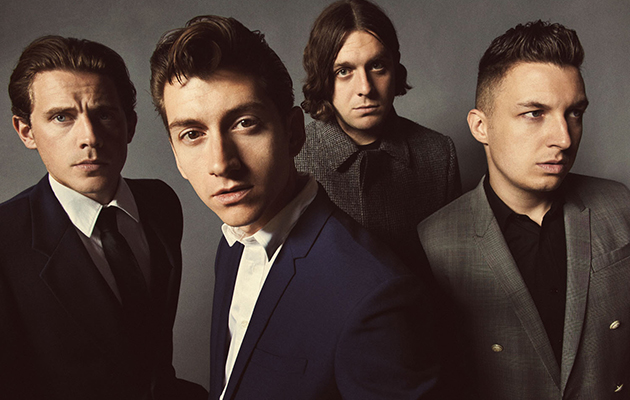Joshua Tree, California isn’t local to many places. Gram Parsons would disappear here. Ecologists commune with the environment here. Psychedelic adventurers take peyote in the desert here. “It’s quiet at night,” remembers Nick O’Malley, fondly. “Except for all the people making rock music at three in the morning.”
Joshua Tree is the site of Rancho De La Luna – a recording studio with strong associations with the “desert rock” scene based around Queens Of The Stone Age’s Josh Homme. It’s not quite correct to say that it’s off the map – there’s a satellite reference – but it’s certainly a long way from Yorkshire.
“It was a question of ‘get out of your comfort zone’,” reflects Alex Turner today, “or bust.”
Arctic Monkeys came to Rancho De La Luna to extend their range. With Whatever People Say I Am… having established them as romantic chroniclers of a nation’s weekend pastimes, they rapidly followed it up with 2007’s Favourite Worst Nightmare. That album (another No 1) was, thinks producer James Ford, one that the band wanted “to get out of the way… to prove the first one wasn’t a fluke”.
Rather than continue in the same bankable vein, Laurence Bell, boss of Domino Records, made a suggestion for their third. If you’re such big fans of Queens Of The Stone Age (“We play them in the van,” Turner told me in 2007. “They’re the only thing we can agree on…”), why not go and work with Josh Homme? It was a decision befitting a band with broadening horizons. Having been previously all about new music, Jamie Cook recalls the period as one of “digging back” into records from the past. He got into Creedence Clearwater Revival, and the solo records of Roky Erickson.
“Then you go back to 13th Floor Elevators,” he recalls, “you find out the whole story. Then you’re in that world and listen to those bands. I’d never really heard heavy psych music. Why would I? I’m 20 and from Sheffield! But it’s another world altogether – there was tons of stuff to listen to.”
Having previously been all about delivering the songs, Arctic Monkeys now experimented with the whole immersive business of how a record might not just be heard, but experienced. The third Arctic Monkeys LP, 2009’s Humbug, isn’t everyone’s favourite, but as people have told Turner, that’s because they’re not engaging with it properly.
“My mate Bill Ryder-Jones says that people not liking Humbug is just one of those things people get in their heads,” says Turner, “like, ‘Ringo can’t play the drums,’ when in fact he’s amazing. I’m not saying it’s amazing… but it has merit.”
The album provided a eureka moment. Not that the personnel at the studio were the kind of people who were into labels like that. “The Rancho has a vibe,” says Alain Johannes, the Queens Of The Stone Age guitarist who worked alongside Homme on the album. “There were always unusual pieces lying around. Everything is the opposite of a, quote-unquote, professional studio: ‘What is this – are you sure it’s a mic? It looks like a grenade…’ You plug it in… find out if it goes off.”
The Rancho mood is about abandoning preconception, about blurring boundaries. “When Josh is producing, he folds inside the paradigm,” explains Alain Johannes. “When cool artists work together, everyone walks away with a little piece of the other person’s perspective inside them – kind of like a holographic thing.”
After having made records featuring songs that were brought to the studio in near-complete form, with Homme’s guidance, Arctic Monkeys embraced a seat-of-pants approach. “There was a cool exchange about the sonics,” recalls Johannes. “Sometimes we would track stuff outside. There’s the [Joshua Tree National] park outside, which is fantastic – you couldn’t possibly have a deader space.
“The thing evolved organically,” he continues. “There was some talking about it, but as far as I was concerned we were talking about something after it had happened. It just kind of flowed really well. It was a tremendous amount of fun.”
“Josh made us believe in ourselves, really,” says Jamie Cook. “He’s got a charm, he can persuade you to do things. We’d never done slow, heavy rock songs. It was a different world to us. I don’t know if we’d have gone there if it hadn’t been for Josh. He used to tell us, ‘It’s harder to play slow.’”
“After Favourite Worst Nightmare there was a conscious decision not to do the same thing again,” says Nick O’Malley, “and Josh had a big influence on it. When we were recording it, he said he didn’t want us to sound too much like the desert. He was worried he was going to make us sound too much like Queens. We said, ‘Great!’ but he’s not that vain – he knew it would be a bad idea.”
“I thought the third album was their bravest,” says James Ford, who “helped finish off” Humbug. “They were big fans of Josh’s, so it made sense to work with him. It really helped define the sound of that record: the grimy, low-slung guitars. It’s Morricone-esque, a cinematic feeling. That’s in the sound and in the songs. It was the start of their love affair with America.”
It is sometimes said that in life it’s not a question so much of where you’re from, as where you’re at – at Rancho De La Luna, Arctic Monkeys had started to fully explore that idea.
“We said, ‘Is this too weird?’” says Matt Helders. “But we got constantly reassured by Josh: ‘This is you – this is Arctic Monkeys.’ He was the one who made us believe that – whatever we do, it’s still going to sound like us.”
“I remember getting there, being as far from home as I’d ever felt,” Turner says, “but also very much at home. You start thinking of what are people going to think about it. But it all went away and we were able to just do this…”
For a revelatory excursion, Alex uses a mind-expanding phrase. “…The doors of perception swung open.”



